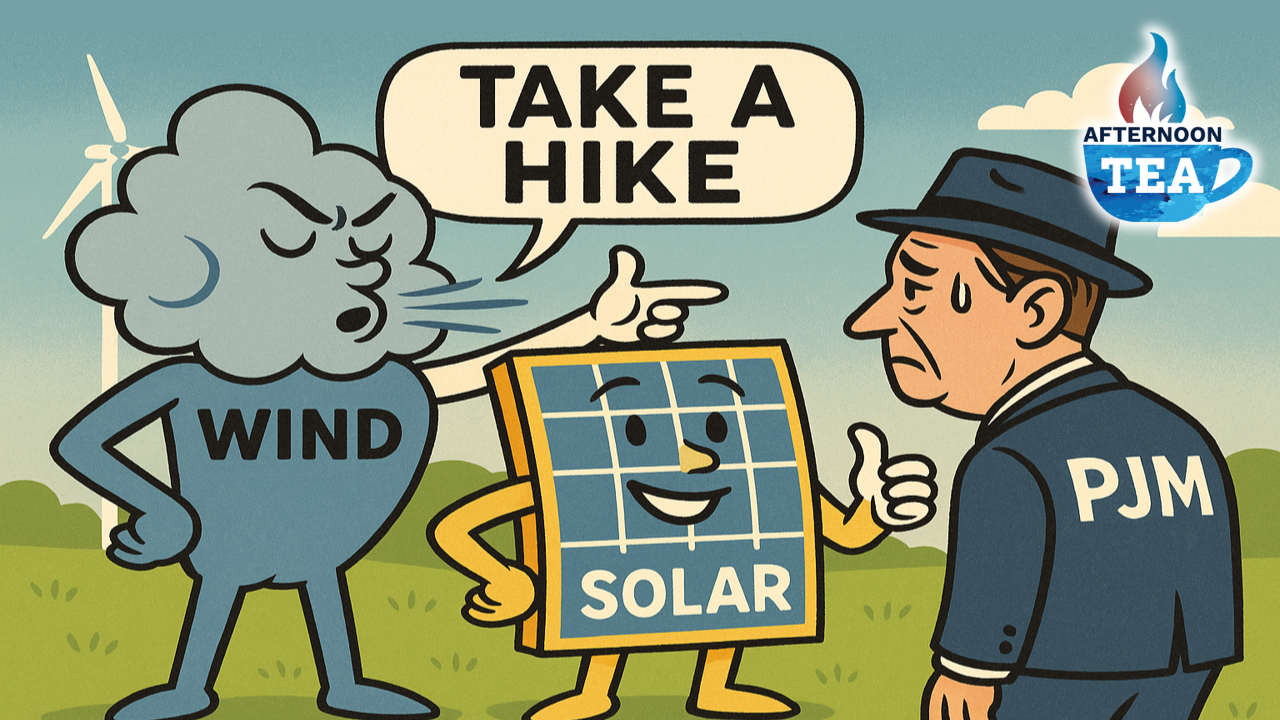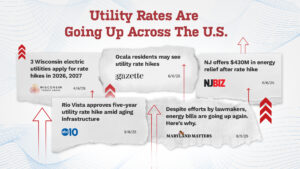
“Take A Hike” Wind and Solar Tell Grid Operators
June 16, 2025
Utility Rate Hikes Across the Country.
Just as we all start cranking up our air conditioners for the impending summer heat, many American families and businesses are facing ever-rising prices for the electricity that powers our lives. In recent weeks, there have been reports across the country of utility rates being hiked for U.S. consumers.

- American Electric Power of Ohio (AEP) has filed a request with the state Public Utilities Commission to hike base electricity rates by 2.14%. That particular request could take a while to make it to consumers, but Ohio residents also face an immediate increase in pass through charges that could cost the average resident $27 more a month.
- In Michigan, Consumers Energy filed a rate hike request with the Michigan Public Service Commission asking for a more than 10 percent rate increase, the largest request from the utility in over a decade. This follows a $153 million rate hike request that just went into effect in April. The state’s attorney general has intervened due to the large requests.
- In Montana, NorthWestern Energy took advantage of a loophole in the state’s laws that allows utilities to increase rates on its own in the state by 17 percent—an equivalent of more than $200 a year for consumers—because the state’s Public Service Commission did not act on an increase request fast enough.
These are just a few examples of a the rate increasing trend Americans are facing all across the country.
Rate Hikes Outpace Inflation.
As the blog Energy Bad Boys explains, “In much of the country, electric companies are government-approved monopoly utilities that have the exclusive right to sell electricity in their service territories. Because electric companies are monopolies, it would be unfair to let them charge whatever they wish for electricity, so electricity prices are set by government regulatory bodies that oversee utilities, often called Public Utilities Commissions (PUCs) or Public Service Commissions (PSCs). When electric and gas utility companies want to raise prices on customers to pay for additional expenses, they must file rate cases with the PUC or PSC that justify the additional expenses in the company’s request.”

These kinds of rate increases from U.S. utilities have unfortunately become common-place. In 2022, utility rate increase requests set a new record high with amounts sought being three times higher than those at the beginning of the pandemic in 2020. But the uptick started even before the pandemic and the inflation that dragged the American economy in recent years. In 2019, 147 new rate increase cases were filed around the country—that’s the most in nearly 50 years since 1983. According to the U.S. Energy Information Administration (EIA), retail electricity prices have increased faster than inflation since 2022. And, the agency expects that trend to continue through 2026.
Why Are Prices Going Up?
A 2024 analysis from EIA showed that major utilities are spending more and more to produce and deliver electricity. The cost for production and delivery increased 12% from $287 billion in 2003 to $320 billion in 2023 as measured in real 2023 dollars.
According to EIA: “Capital investment in electric infrastructure mostly drove the increase, more than doubling over the period as:
- Aging generation and delivery infrastructure were replaced or upgraded to resist fire and storm damage.
- Utilities installed first natural gas-fired generation, then wind and solar generation, and, more recently, battery storage.
- New lines were connected to renewable resources.
- New technology, including smart meters, sensors, and automated controls, was added to the system.”
In the case of AEP Ohio’s current request, the utility rate increase would be to invest in aging infrastructure like poles, wires, transformers and other equipment to avoid power outages. The pass through charges however are due to growing supply and demand concerns, especially with the influx of power-hungry data centers in the state.

But, these costs aren’t always just a natural side effect of an aging grid. Some are driven by the sources of electricity that state governments and utility commissions are choosing to invest in, and by the federal subsidies that have been doled out to prop up more “clean” energy.
According to S&P Global: “Spending is driven by pent-up demand to replace and modernize aging infrastructure, renewable portfolio standards of multiple states — which include large expansions in low-carbon energy generation capacity — continuing to ramp up, and federal infrastructure investment plans that are intended to steer conversion of the nation’s power generation network to zero-carbon sources by 2035 … Utilities have been drastically ramping up capital spending plans since President Biden signed the Inflation Reduction Act into law in August 2022. The law features $370 billion in spending and tax incentives intended to spur clean energy investments.”
Yes, Wind and Solar Do Cost You More.
And, artificially propping up wind and solar energy, rather than letting the market drive which energy sources are the most affordable, reliable and clean, is costing American consumers. In 2022, the Energy Bad Boys blog looked at the largest rate increase requests across the country. Their analysis found that “every single one of the eight companies listed wind and solar investments or the energy transition as one of the primary reasons for raising electricity prices, and multiple companies explicitly cited state mandates for clean energy or GHG reductions to justify the rate increases.”
In that year, the largest rate increase in the country came from Pacific Gas and Electric, which cited its commitment to “California’s bold climate and clean energy goals and to actions that reduce greenhouse gas emissions, including delivering low-carbon energy.”

According to the blog, “As wind and solar energy penetration levels began to rise above 5 percent, California electricity prices began skyrocketing, erasing nearly a decade of price normalization with the US average. In 2022, with wind and solar generation levels above 25 percent, the average electricity price in California was 81 percent higher than the national average, compared to a low of 28 percent in 2008 when the Golden State’s generation mix only had 3 percent wind and solar.”
The world is changing in a way that will only increase demand for electricity and all energy sources. Increased electrification for residential resources and transportation will fuel more and more demand from everyday Americans to meet their energy needs. And, the growing tech boom in data centers is going to place an unprecedented draw on our energy system. The centers where tech companies house their artificial intelligence models consume electricity 24/7 and in some case require as much energy as a city.
That’s why we must make smart decisions now for consumers suffering under rate increases and for the exponential growth in future demand. Wind and solar energy can and should be part of the mix but only as they can compete with other traditional energy sources like natural gas for affordability and reliability. Green-at-any-cost agendas may make for feel good lines in utilities’ annual reports and politician’s rhetoric, but they should not be what drives our electricity mix. Americans need affordable, reliable and clean energy sources and they need leaders that embrace policies like the ARC ES legislation to make sure we are building an energy future that Americans can both trust and afford.